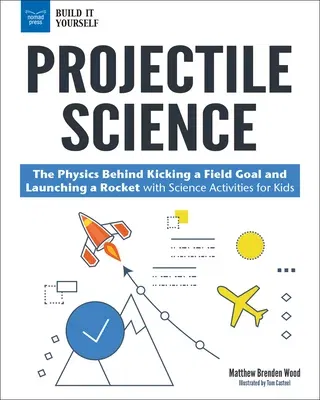What are the forces behind ballistics? Why do rocks and rockets soar
through the air in an arch?
The game is on the line. Suddenly, you hear the crack of a bat and the
roar of crowd. Where will the ball land? How far will it travel? Is it a
home run?
You might think that hitting a home run or nailing a three-pointer is
just luck, but there are many forces at work that determine if you've
made a game-winning shot or the final out. If you've ever kicked a ball,
thrown a rock, or even played Angry Birds, you've experimented with the
forces behind ballistics.
In Projectile Science: The Physics Behind Kicking a Field Goal and
Launching a Rocket with Science Activities for Kids, one of four
titles in the Technology for Today set, kids ages 10 to 15 learn why
projectiles follow the paths they do and what factors influence those
paths. Readers who are fascinated with potato cannons, slingshots, and
rocketry will love taking that next step and applying what they learn
about the laws of physics to the science of figuring out where to aim.
Math is the language you use to understand the science of ballistics. In
this book, readers will learn about the forces that act on the
projectiles and how to calculate those forces to make educated
predictions about where their homemade rockets and other projectiles
will land. 25 Safe, hands-on STEAM activities using materials that are
easy to acquire are a terrific way to foster real-life learning about
ballistics. Kids will perform Galileo's famous test for gravity, create
clinometers to measure height and distance, and build a machine that can
throw curve balls.
Essential questions that promote critical examination of the science,
primary sources, online videos, and science-minded engineering
activities let readers have a blast learning about the physics of
ballistics!
In the Technology for Today set, readers ages 10 to 15 explore the
digital and tech landscapes of today and tomorrow through hands-on STEAM
activities and compelling stories of how things work, who makes them
work, and why. Titles in this set include Industrial Design: Why
Smartphones Aren't Round and Other Mysteries with Science Activities for
Kids; Big Data: Information in the Digital World with Science
Activities for Kids; Projectile Science: The Physics Behind Kicking a
Field Goal and Launching a Rocket with Science Activities for Kids; and
Artificial Intelligence: Thinking Machines and Smart Robots with
Science Activities for Kids.
Nomad Press books integrate content with participation. Common Core
State Standards, the Next Generation Science Standards, and STEM
Education all place project-based learning as key building blocks in
education. Combining content with inquiry-based projects stimulates
learning and makes it active and alive. Nomad's unique approach
simultaneously grounds kids in factual knowledge while allowing them the
space to be curious, creative, and critical thinkers.

